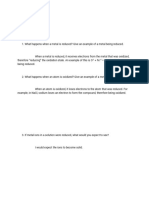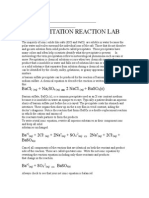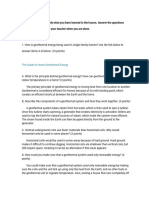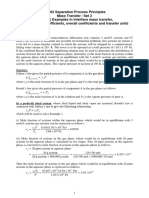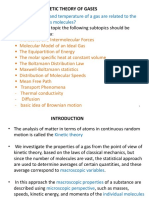4.4.4 Lab: Precipitation Reactions: Points Possible:50
4.4.4 Lab: Precipitation Reactions: Points Possible:50
Uploaded by
Sid MathurCopyright:
Available Formats
4.4.4 Lab: Precipitation Reactions: Points Possible:50
4.4.4 Lab: Precipitation Reactions: Points Possible:50
Uploaded by
Sid MathurOriginal Title
Copyright
Available Formats
Share this document
Did you find this document useful?
Is this content inappropriate?
Copyright:
Available Formats
4.4.4 Lab: Precipitation Reactions: Points Possible:50
4.4.4 Lab: Precipitation Reactions: Points Possible:50
Uploaded by
Sid MathurCopyright:
Available Formats
4.4.
4 Lab: Precipitation Reactions Pre-lab
Chemistry Honors Sem 1 Name: Sidhant Mathur
Points Possible:50
Date:
Answer these questions before beginning the lab. Be sure to turn them in when you submit
your lab report.
1. Why do some combinations of ionic compounds form a precipitate while others do not?
A precipitate is formed when one of the compounds is insoluble.
2. Solutions of lead(II) nitrate and potassium iodide were combined in a test tube. The
results of this reaction are shown below.
a. Write a formula equation for the reaction.
Pb(NO3)2 + 2KI → PbI2+2KNO3
b. Which of the possible products is the precipitate, and how do you know?
PbI2 is most likely the precipitate. I can determine this because according to the
solubility rules, Pb2+ is insoluble, which would mean the compound with it would be the
precipitate.
c. Write a complete ionic equation for the reaction and identify the spectator ions.
2K+(aq) + 2I-(aq) + Pb2+(aq) + 2NO3-(aq) PbI2(s) + 2K+(aq) + 2NO3-(aq)
Spectator Ions: K+, NO3-
d. Write a net ionic equation for the reaction between lead(II) nitrate and potassium
iodide.
Pb2+(aq) + 2I-(aq) → PbI2(s)
Lab 4.4.4 (Dry Lab)
1. Write a balanced chemical equation for each double replacement reaction that occurs. Note:
Compounds with Na+, K+, and/or NO3 − are soluble.
Ca(NO₃)₂ + 2 KOH → Ca(OH)₂ + 2 KNO₃
Ca(NO₃)₂ + Na₂C₂O₄ → CaC₂O₄ + 2 NaNO₃
Cu(NO₃)₂ + 2 KI → CuI₂ + 2 KI
Cu(NO₃)₂ + 2 KOH → Cu(OH)₂ + 2 KNO₃
Cu(NO₃)₂ + Na₂C₂O₄ → CuC₂O₄ + 2 NaNO₃
Ni(NO₃)₂ + 2 KOH → Ni(OH)₂ + 2 KNO₃
Ni(NO₃)₂ + Na₂C₂O₄ → NiC₂O₄ + 2 NaNO₃
Zn(NO₃)₂ + 2 KOH → Zn(OH)₂ + 2 KNO₃
Zn(NO₃)₂ + Na₂C₂O₄ → ZnC₂O₄ + 2 NaNO₃
2. Why was there no reaction in some of the wells? (See Introduction.)
A double replacement reaction takes place only if it reduces the concentration of ions in
the solution. Also, some of the reactions did not lead to precipitates or gases.
3. How could you tell a Ca(NO3 )2 solution from a Zn(NO3 )2 solution?
Using the table provided, both solutions react with KOH. However, one solution appears
to react more than the other. To determine which solution is which, assuming both solutions are
unknown, we can add an equal amount of KOH to both solutions. According to the table, the
solution that forms a faint, white precipitate is Ca(NO3)2, while the other solution is Zn(NO3)2.
4. How could you tell a Cu(NO3 )2 solution from a Ni(NO3 )2 solution?
Using a similar method to the previous question, we can see that Cu(NO3)2 reacts with
KI, while the other solution does not. To determine which is which, assuming both solutions are
unknown, we can add an equal amount of Kl to both solutions. The one that reacts is Cu(NO3)2,
while the other one is Ni(NO3)2.
You might also like
- 5.6.4 Journal: Designing A Mountain LandscapeDocument3 pages5.6.4 Journal: Designing A Mountain Landscapewriter top60% (10)
- LAB 3: Periodic Properties: With ExtensionDocument6 pagesLAB 3: Periodic Properties: With ExtensionYoon Yoon57% (7)
- 2.4.3 Dry LabDocument5 pages2.4.3 Dry LabYoon Yoon58% (12)
- 3.7.5 Practice - Modeling - Pumpkin LaunchDocument7 pages3.7.5 Practice - Modeling - Pumpkin LaunchLyriq Wooten100% (1)
- Dry Lab 1.3.3Document5 pagesDry Lab 1.3.3Yoon Yoon100% (1)
- Types of Bonds AP ChemistryDocument6 pagesTypes of Bonds AP Chemistry중국이수아100% (1)
- 4.3.5 Practice - Chemical Reactions (Practice)Document11 pages4.3.5 Practice - Chemical Reactions (Practice)Bertonn100% (1)
- Intermolecular Forces POGIL-1Document7 pagesIntermolecular Forces POGIL-1Crystal R.M100% (2)
- 5.3.5 ChemistryDocument13 pages5.3.5 ChemistrySean Citherlet67% (18)
- Lab 4.4.3 ChemistryDocument4 pagesLab 4.4.3 ChemistrySean Citherlet0% (6)
- 1-3-4-Lab ChemistryDocument5 pages1-3-4-Lab ChemistryKool Beans0% (1)
- 2.3.5 Practice - Atomic Structure (Practice)Document11 pages2.3.5 Practice - Atomic Structure (Practice)Jasmin SahotaNo ratings yet
- Algebra 1 - 4.1.4 Journal PDFDocument5 pagesAlgebra 1 - 4.1.4 Journal PDFbailey0% (1)
- KVS Lucknow XII CHE QP & MS Pre-Board (23-24)Document11 pagesKVS Lucknow XII CHE QP & MS Pre-Board (23-24)GuestNo ratings yet
- 5.5.1 PracticeDocument12 pages5.5.1 PracticeSid MathurNo ratings yet
- 5.5.1 PracticeDocument12 pages5.5.1 PracticeSid MathurNo ratings yet
- 2.4.3 Lab - Mass, Volume, and Density (Pre-Lab)Document3 pages2.4.3 Lab - Mass, Volume, and Density (Pre-Lab)zsolmazNo ratings yet
- Kami Export - 3.1.3 Practice - Be Your Own Heart Rate Monitor (Practice)Document4 pagesKami Export - 3.1.3 Practice - Be Your Own Heart Rate Monitor (Practice)David ScanlonNo ratings yet
- Apex Learning - 10.4.4 Pre-LabDocument2 pagesApex Learning - 10.4.4 Pre-LabPrerna Kotwani (DH)100% (2)
- 5.4.3 Lab - Molecular Models (Pre-Lab)Document4 pages5.4.3 Lab - Molecular Models (Pre-Lab)Emma VillasenorNo ratings yet
- Journal 3.2.5Document2 pagesJournal 3.2.5Estella ReyesNo ratings yet
- Lab 2Document3 pagesLab 2Kaelie TuszkiewiczNo ratings yet
- 1.1.5 JournalDocument2 pages1.1.5 JournalEstella ReyesNo ratings yet
- Freezing Point Depression: GoalsDocument4 pagesFreezing Point Depression: GoalsBrandon Chan0% (2)
- Journal 2.2.5Document2 pagesJournal 2.2.5Estella Reyes0% (1)
- Exploration: 5.1.5 Explore: Fighting Free RadicalsDocument5 pagesExploration: 5.1.5 Explore: Fighting Free RadicalsSid Mathur100% (1)
- Exploration: 5.1.5 Explore: Fighting Free RadicalsDocument5 pagesExploration: 5.1.5 Explore: Fighting Free RadicalsSid Mathur100% (1)
- Week9 Tut SolnDocument12 pagesWeek9 Tut Solnsharise1100% (1)
- Directions:: 5.4.3 Lab: Oxidation-Reduction ReactionsDocument2 pagesDirections:: 5.4.3 Lab: Oxidation-Reduction Reactionsapi-295022310No ratings yet
- Answer These Questions Before Beginning The Lab. Be Sure To Turn Them in When You Submit Your Lab ReportDocument4 pagesAnswer These Questions Before Beginning The Lab. Be Sure To Turn Them in When You Submit Your Lab ReportSid Mathur100% (2)
- 3.4.4 Lab: Periodic Properties: Points Possible:50Document3 pages3.4.4 Lab: Periodic Properties: Points Possible:50Sid MathurNo ratings yet
- Journal 5.1.5Document1 pageJournal 5.1.5Estella ReyesNo ratings yet
- Question 1: Thermal Energy and Heat Transfer (4 Points)Document10 pagesQuestion 1: Thermal Energy and Heat Transfer (4 Points)Sid MathurNo ratings yet
- Lab 6 Freezing Point DepressionDocument6 pagesLab 6 Freezing Point DepressionShema BrunoNo ratings yet
- 5.2.5 Chuck Adkins JournalDocument8 pages5.2.5 Chuck Adkins JournalChuck AdkinsNo ratings yet
- Apex Learning - TestDocument11 pagesApex Learning - TestMica Mellberg100% (1)
- Apex Learning - ExplorationDocument3 pagesApex Learning - ExplorationLogan Clark67% (3)
- Student Exploration: Chemical ChangesDocument8 pagesStudent Exploration: Chemical ChangesTasia L60% (5)
- NatalyStephany Pinguil - Copy of IonicBondsSEDocument5 pagesNatalyStephany Pinguil - Copy of IonicBondsSEnataly natiNo ratings yet
- Question 1: Thermal Energy and Heat Transfer (4 Points)Document10 pagesQuestion 1: Thermal Energy and Heat Transfer (4 Points)Sid MathurNo ratings yet
- 5.4.3 LabDocument4 pages5.4.3 LabSid Mathur100% (1)
- 4.2.5 JournalDocument2 pages4.2.5 JournalEstella ReyesNo ratings yet
- 3.3.5 Bonding in Matter ChemDocument7 pages3.3.5 Bonding in Matter ChemCarina Silva-RomeroNo ratings yet
- 9.3.5 Practice - Transferring Energy (Practice)Document8 pages9.3.5 Practice - Transferring Energy (Practice)amazingu820No ratings yet
- 2.4.4 Lab - Disturbing Equilibrium (Pre-Lab)Document2 pages2.4.4 Lab - Disturbing Equilibrium (Pre-Lab)graysnow816No ratings yet
- 4.5.1 Practice - Chemical Reactions (Practice)Document16 pages4.5.1 Practice - Chemical Reactions (Practice)russellyeet39100% (1)
- Question 1: Matter and Energy (10 Points)Document4 pagesQuestion 1: Matter and Energy (10 Points)Gurjot PhulNo ratings yet
- 3.1.5 Explore - Defining Electronegativity (Exploration)Document3 pages3.1.5 Explore - Defining Electronegativity (Exploration)SandyNo ratings yet
- Mass, Volume, and Density: Goals Shape Formula Symbols Table 2.1Document5 pagesMass, Volume, and Density: Goals Shape Formula Symbols Table 2.1SandyNo ratings yet
- Precipitation Reactions: GoalsDocument5 pagesPrecipitation Reactions: GoalsBob Jamss0% (2)
- Lab 8 - Heats of ReactionDocument4 pagesLab 8 - Heats of ReactionemmaharukahuangNo ratings yet
- 1.1.10 Practice - Complete Your Assignment (Practice)Document5 pages1.1.10 Practice - Complete Your Assignment (Practice)FizzlesNo ratings yet
- LAB 3: Periodic Properties: GoalsDocument6 pagesLAB 3: Periodic Properties: GoalsBob JamssNo ratings yet
- 5.1.4 Practice - Modeling - Multiplying Polynomials (Practice)Document5 pages5.1.4 Practice - Modeling - Multiplying Polynomials (Practice)Aung KaungNo ratings yet
- 11.3.5 Lab - Document Enteripse Cybersecurity IssuesDocument5 pages11.3.5 Lab - Document Enteripse Cybersecurity IssuesPuerkos by NatureNo ratings yet
- Freezing Point Depression Lab - Teacher VersionDocument5 pagesFreezing Point Depression Lab - Teacher VersionTeachLABScINo ratings yet
- Electronconfiguration 1Document14 pagesElectronconfiguration 1api-28543186853% (15)
- 4.2.5 Explore - Hard Water and Ion Exchange (Exploration)Document5 pages4.2.5 Explore - Hard Water and Ion Exchange (Exploration)russellyeet39No ratings yet
- 3.5.1 Practice - Bonding in Matter (Practice)Document17 pages3.5.1 Practice - Bonding in Matter (Practice)russellyeet39No ratings yet
- Precipitation LabDocument4 pagesPrecipitation LabMaria Zarah MenesesNo ratings yet
- 4.3.4 Practice - Modeling - Two-Variable Systems of Inequalities (Completed 2) - 4003004 - 8DBnCBX4HDocument4 pages4.3.4 Practice - Modeling - Two-Variable Systems of Inequalities (Completed 2) - 4003004 - 8DBnCBX4HzraootNo ratings yet
- 3.3.5 Practice - Bonding in Matter (Practice)Document9 pages3.3.5 Practice - Bonding in Matter (Practice)Optic Vengeance0% (1)
- Dot Structures Practice PacketDocument6 pagesDot Structures Practice Packetgoogley71No ratings yet
- Chemistry Labwork: Lamia Sabry Marwa Al-Kandari Maya Zeini Nehl Karim Rasha Al-AssmiDocument11 pagesChemistry Labwork: Lamia Sabry Marwa Al-Kandari Maya Zeini Nehl Karim Rasha Al-Assmideepheat_008No ratings yet
- Sample Paper Chemistry Clas Xi Set 5Document9 pagesSample Paper Chemistry Clas Xi Set 5abhijeetkumar12345trNo ratings yet
- In This Practice, You Will Apply What You Have Learned in The Lesson. Answer The Questions Below. Submit This Sheet To Your Teacher When You Are DoneDocument3 pagesIn This Practice, You Will Apply What You Have Learned in The Lesson. Answer The Questions Below. Submit This Sheet To Your Teacher When You Are DoneSid MathurNo ratings yet
- Question 1: Thermodynamics (9 Points)Document8 pagesQuestion 1: Thermodynamics (9 Points)Sid MathurNo ratings yet
- In This Test, You Will Apply What You Have Learned in The Unit. Please Answer The Questions Below. Submit The Test To Your Teacher When You Are DoneDocument8 pagesIn This Test, You Will Apply What You Have Learned in The Unit. Please Answer The Questions Below. Submit The Test To Your Teacher When You Are DoneSid MathurNo ratings yet
- 2.5.4 TSTDocument19 pages2.5.4 TSTSid MathurNo ratings yet
- 5.4.3 LabDocument4 pages5.4.3 LabSid Mathur100% (1)
- Helium AtomDocument8 pagesHelium AtomehmedNo ratings yet
- PrintDocument2 pagesPrintJessica SaballeroNo ratings yet
- Trunnion & Shoe Temp. Calculation.Document27 pagesTrunnion & Shoe Temp. Calculation.Bharat Bellad100% (1)
- Reaction Rate Theory and Rare Events Simulations Baron Peters Download PDFDocument37 pagesReaction Rate Theory and Rare Events Simulations Baron Peters Download PDFmasoteizrulNo ratings yet
- Chem 11 Unit 7 PPT 3 HebdenDocument32 pagesChem 11 Unit 7 PPT 3 HebdenMarina XuNo ratings yet
- Itmti Chemistry Term 2 STPM Chapter 7 Chemical EnergeticsDocument47 pagesItmti Chemistry Term 2 STPM Chapter 7 Chemical EnergeticsCherry T CYNo ratings yet
- 11th Chemistry Centum Coaching Team Question Paper English MediumDocument5 pages11th Chemistry Centum Coaching Team Question Paper English MediumpradeepvcpNo ratings yet
- Chemistry P2Document12 pagesChemistry P2Badmind JnrNo ratings yet
- RecoveryPlant DistilleryDocument2 pagesRecoveryPlant DistilleryDimas Eko PrasetyoNo ratings yet
- Hydrogen NcertDocument18 pagesHydrogen NcertTr Mazhar PunjabiNo ratings yet
- Hydrotreating Catalysts, An Old Story With New ChallengesDocument17 pagesHydrotreating Catalysts, An Old Story With New ChallengesJulio Adolfo López PortocarreroNo ratings yet
- Arrhenius EquationDocument5 pagesArrhenius EquationSham SajaNo ratings yet
- Haber Process and AmmoniaDocument2 pagesHaber Process and AmmoniaAaron HongNo ratings yet
- Spectrophotometric Determination of Iron in Natural Water (Experiment 13)Document5 pagesSpectrophotometric Determination of Iron in Natural Water (Experiment 13)Caleb JalmascoNo ratings yet
- CP302 Separation Process Principles Mass Transfer / Set 2 (Worked) Examples in Interface Mass Transfer, Mass Transfer Coefficients, Overall Coefficients and Transfer UnitsDocument4 pagesCP302 Separation Process Principles Mass Transfer / Set 2 (Worked) Examples in Interface Mass Transfer, Mass Transfer Coefficients, Overall Coefficients and Transfer Unitsأثير عبد الباري يعقوبNo ratings yet
- Basic LNG Training: Presented By: Saurabh Girdhar Head, Marine Division. Ganpat UniversityDocument85 pagesBasic LNG Training: Presented By: Saurabh Girdhar Head, Marine Division. Ganpat UniversityVu Duc NguyenNo ratings yet
- Practice Sets All Organic Chemistry 1Document64 pagesPractice Sets All Organic Chemistry 1Tôi TellNo ratings yet
- Heat Mass and Transfer REPORT 2Document14 pagesHeat Mass and Transfer REPORT 2Katlego NathanNo ratings yet
- Chemical Engineering Board Exam PDFDocument3 pagesChemical Engineering Board Exam PDFJohn Leonard FazNo ratings yet
- 1A03 2023 Skeleton NotesDocument52 pages1A03 2023 Skeleton Noteszaina.shaikh2005No ratings yet
- Thermo ChemistryDocument31 pagesThermo Chemistrynosirat aladeNo ratings yet
- Heat Recovery Steam Generator - HRSG General Usage: Combined-Cycle Gas Turbine CogenerationDocument4 pagesHeat Recovery Steam Generator - HRSG General Usage: Combined-Cycle Gas Turbine CogenerationGustavo FamaNo ratings yet
- Worksheet D and F Block ElementDocument2 pagesWorksheet D and F Block Elementdp966889100% (1)
- Group V Cations-ClassB AnionsDocument4 pagesGroup V Cations-ClassB AnionsApril Mergelle LapuzNo ratings yet
- TCCA - US5039800 - P - Process For Producing Trichloroisocyanuric AcidDocument7 pagesTCCA - US5039800 - P - Process For Producing Trichloroisocyanuric AcidListya Eka AnggrainiNo ratings yet
- Estimation Total Equivalent TemperatureDocument8 pagesEstimation Total Equivalent TemperatureNandan RajeNo ratings yet
- 3 Kinetic Theory of GasesDocument69 pages3 Kinetic Theory of GasesEDENINo ratings yet
- Translate 2.6.3 - Determination of Z-FactorDocument2 pagesTranslate 2.6.3 - Determination of Z-FactorelaNo ratings yet





































